EXPERIENCE: ALONG THE HANDICRAFT HIGHWAY IN NORTHERN THAILAND
The road that runs east from Chiang Mai to San Kamphaeng in northern Thailand is marked on maps as Highway 1006, but it is known locally by a more colourful name – the Handicraft Highway. This is because the road is lined with artisans’ workshops and showrooms where you can see both the processes and products of the handicrafts for which northern Thailand is famous.
These handicrafts include silk and silverware, lacquerware, ceramics, umbrellas and fans, and a trip down the Handicraft Highway is one of the most interesting activities for visitors to Chiang Mai. It offers the chance not only to meet local people, but also to learn something of the techniques used in producing traditional handicrafts, and to pick up a striking souvenir to take back home.
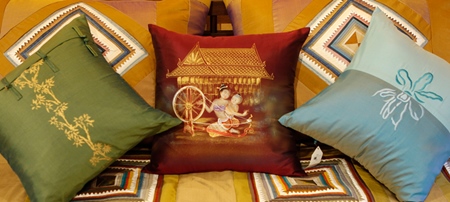
The first stop along the highway is usually to see the silk weaving process. You can watch silk worms at different stages of growth, the method of collecting the silk from the cocoon (each cocoon produces about 300 meters of raw silk), the spinning of it into thread, the dyeing process, and the labour-intensive weaving of plain and patterned cloth, which is still done on cumbersome wooden looms.

Thai silk is one of the country’s most popular buys, either in the form of ready-made clothes, or in the form of bedspreads, cushion covers, scarves and purses, which are usually decorated with distinctive Thai motifs.
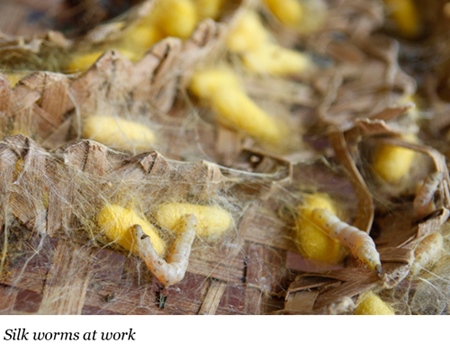
The gleam of silverware catches the eye of many visitors, and watching silversmiths at work is an absorbing activity. Modern showrooms along the Handicraft Highway display a variety of items, the most famous being bowls featuring characters from the Ramakien, the Thai version of the Indian Ramayana epic.
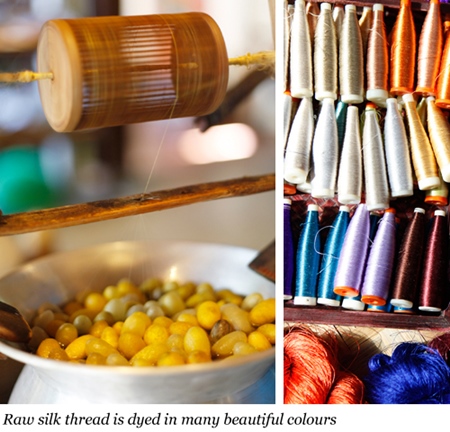
Behind these modern showrooms lie forges that consist of little more than a roof and furnace, where the silversmiths, intent on their work, wield hammers and create works of art in the same way as their forefathers have done for centuries. Most of the silver used in the production of these objects is of extremely high quality and, in some cases, is 100% pure.
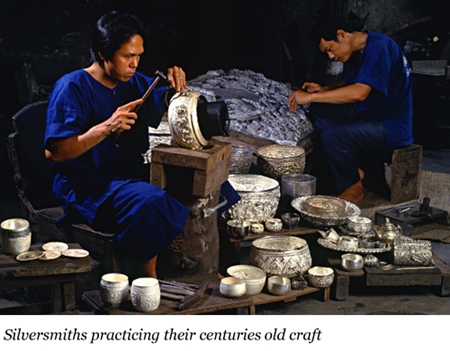
Perhaps the most practical craft to take home as a gift is lacquerware, which is very light to carry and at the same time typically Thai, although some designs show a Burmese influence that reflects the intermingling of these cultures over the centuries. Glossy trays, bowls, vases and jewellery boxes are the most common products, traditionally finished in black and gold but sometimes in other colours.
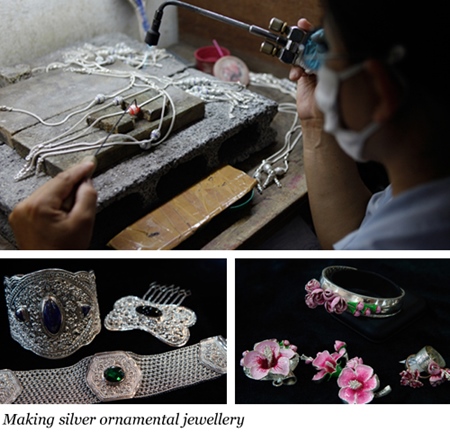
Making lacquerware goods is a time-consuming process that shows the Thais’ seemingly infinite patience. The artisans begin by making a frame of bamboo strips, on which they then apply various layers of lacquer. A typical piece requires between seven and twelve layers, each of which must be left to dry for about a week. The object is then polished with a combination of ash and clay. The best quality lacquer is kept for the final coat, after which the glistening black base is painted or embossed with intricate gold designs.
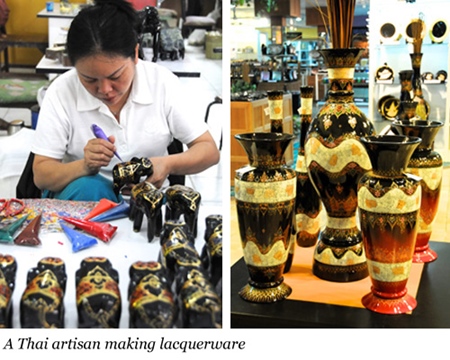
Ceramics are more fragile than lacquerware to ship or carry across the world, yet they make very popular purchases, especially Thai celadon, which is cracked intentionally to give an intriguing natural pattern beneath the final glaze and is usually finished in a pale green colour. In ceramic workshops along the Handicraft Highway, you can watch the clay being blended in a pug mill, then being thrown on the potter’s wheel before the glaze is applied and the object is fired.

After firing at 1250 degrees Centigrade, celadon items are cooled quickly, which causes the glaze to crack and assures that each item will be totally unique. The wood ash glaze that is applied to celadon mimics the colour of jade and is from the overcus belutina tree, found in densely wooded areas of northern Thailand. By adding tiny quantities of cobalt or iron to the wood ash glaze, celadon also comes in blue or dark green. The most popular items among visitors are dinner sets, although vases, plant pots and figurines made in casts also sell well.
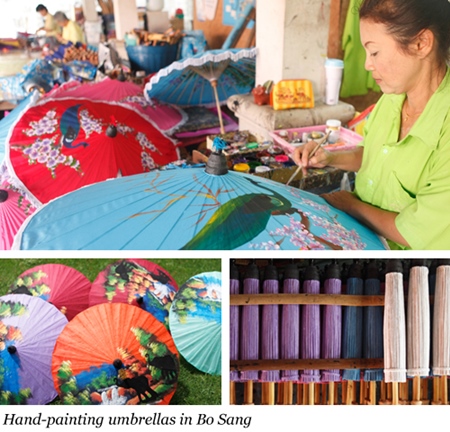
Apart from workshops engaged in all kinds of traditional crafts, the Handicraft Highway also leads to the village of Bor Sang, where it seems that all inhabitants are involved in the production of umbrellas and fans. Dainty toy umbrellas adorned with silk make delightful room decorations, while at the other extreme, some workshops show off their skills by displaying giant umbrellas up to five metres in diameter in front of their showrooms.
As with most local handicrafts, only natural products are used in the making of umbrellas. A wooden handle and bamboo spokes support a top made of “sa” paper, the production of which is a long and arduous craft of its own that involves the pounding of the bark of the sa tree (a type of mulberry) into a pulp, virtually dissolving it in a tank of water, and finally collecting it on a fine mesh to dry.
The hand painting of the umbrellas and fans gives a chance for the painters to dazzle visitors by producing intricate portraits of birds or flowers within seconds. It’s even possible for you to have the jeans or T-shirt you’re wearing painted with a bright design for a small fee.
The vast range of crafts in northern Thailand may seem a bit overwhelming at first, but after a while spent exploring the workshops and showrooms along the Handicraft Highway, you’re sure to find a special reminder of your stay and some distinctive gifts for the folks back home. Chiang Mai may be modernizing at a rapid rate, but its craftsmen are keeping traditional wisdom alive in the hills of northern Thailand.
GETTING THERE:
White songthaew (small trucks that carry passengers) run regularly from Chiang Mai to San Kamphaeng from Praisanee Road by Warorot Market. In order to stop at several workshops and showrooms, it’s more convenient to rent a car or motorbike, with or without a driver, for half a day and explore the Handicraft Highway at your leisure.




